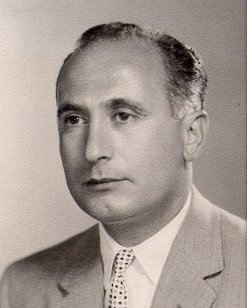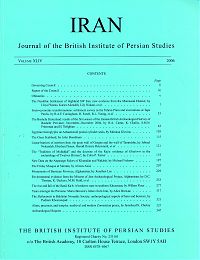The Persians are an Iranian ethnic group who comprise over half of the population of Iran. They share a common cultural system and are native speakers of the Persian language as well as of the languages that are closely related to Persian.

Atropatene, also known as Media Atropatene, was an ancient Iranian kingdom established in c. 323 BC by the Persian satrap Atropates. The kingdom, centered in present-day northern Iran, was ruled by Atropates' descendants until the early 1st-century AD, when the Parthian Arsacid dynasty supplanted them. It was conquered by the Sasanians in 226, and turned into a province governed by a marzban ("margrave"). Atropatene was the only Iranian region to remain under Zoroastrian authority from the Achaemenids to the Arab conquest without interruption, aside from being briefly ruled by the Macedonian king Alexander the Great.

Ehsan Yarshater was an Iranian historian and linguist who specialized in Iranology. He was the founder and director of the Center for Iranian Studies, and Hagop Kevorkian Professor Emeritus of Iranian Studies at Columbia University.
Iranian Canadians or Persian Canadians are Canadians of Iranian origin. From the 2016 Canadian census, the main communities can be found in Southern Ontario, British Columbia, and Quebec. The vast majority, however, live in northern suburbs of Toronto such as Richmond Hill, Vaughan, Markham, and Thornhill, and in certain municipalities of Vancouver, including North Vancouver, West Vancouver, Burnaby, and Coquitlam. As of 2016 a total of 97,110 Iranians reside in the Greater Toronto Area, 46,255 in the Greater Vancouver Area, and 23,410 in the Greater Montreal Area, with the remainder spread out in the other major cities of Canada, based on the 2016 Canadian Census. These numbers represent the people who stated "Iranian" as their single or joint ethnic origin in the census survey.

In the Western world, Persia was historically the common name used for Iran. On the Nowruz of 1935, Reza Shah officially asked foreign delegates to use the Persian term Iran, the endonym of the country, in formal correspondence. Subsequently, the common adjective for citizens of Iran changed from Persian to Iranian. In 1959, the government of Mohammad Reza Pahlavi, Reza Shah's son, announced that both "Persia" and "Iran" could be used interchangeably, in formal correspondence. However, the issue is still debated (see § Recent debate) among Iranians.
Australians in the United Kingdom, or Australian Britons, include Australians who have become residents or citizens of the United Kingdom. The largest segment of Australia's diaspora of 1 million resides in the United Kingdom.
Iranian Australians or Persian Australians are Australian citizens who are of Iranian ancestry or who hold Iranian citizenship.
The page details the timeline of History of Iran.
East Asians in the United Kingdom are East Asians living in the United Kingdom. They have been present in the country since the 17th century and primarily originate from countries such as China, Hong Kong, Japan, South Korea and Taiwan. They are called "East Asian" or "Oriental", although – dependent upon the context – the use of the term "Oriental" might be considered by some to be derogatory or offensive. In the 2001 British census, the term Chinese or Other is used.
Dimdim Castle was a Kurdish fortress located on top of Mount Dimdim in West Azerbaijan Province of Iran, just west of Lake Urmia. This fortress was the location of Battle of Dimdim.
British Iraqis are British citizens who originate from Iraq.
Canadians in the United Kingdom, or Canadian Britons, are people from Canada living in the United Kingdom and their descendants. In 2001 some 72,518 people born in Canada were living in the UK according to the UK census. Of the ten census tracts with the highest Canadian-born populations, nine were in London, with the other being Cambridge West. The Office for National Statistics estimates that, in 2009, 82,000 Canadian-born people were living in the UK. In 2011 this was the third largest community in the Canadian diaspora after Canadians in the United States and Canadians in Hong Kong.
Iranians in France include immigrants from Iran to France as well as their descendants of Iranian heritage or background. Iranians in France are referred to by hyphenated terms such as French-Iranians or French-Persians.

The Pishdadian dynasty is a mythical line of primordial kings featured in Zoroastrian belief and Persian mythology. They are presented in legend as originally rulers of the world but whose realm was eventually limited to Ērānshahr or Greater Iran. Although there are scattered references to them in the Zoroastrian scriptures—the Avesta—and later Pahlavi literature, it is through the 11th-century Iranian national epic, the Shahnameh, that the canonical form of their legends is known. From the 9th century, Muslim writers, notably Tabari, re-told many of the Pishdadian legends in prose histories and other works. The Pishdadian kings and the stories relating to them have no basis in historical fact, however.
Swedish Iranians or Swedish Persians consist of people of Iranian nationality who have settled in Sweden, as well as Swedish residents and citizens of Iranian heritage. As of 2019, there were 80,136 residents of Sweden born in Iran, as well as 40,883 born in Sweden with at least one Iranian-born parent.

Iran: Journal of the British Institute of Persian Studies is an annual peer-reviewed academic journal covering Iranian studies. Its first editor was Laurence Lockhart; other editors included Georgina Herrmann, C. Edmund Bosworth, Vesta Sarkhosh Curtis, and Cameron A. Petrie. It has been published in scholarship by Louis D. Levine, Inna Medvedskaya, Roger Moorey, Michael Roaf, T. Cuyler Young, and Ran Zadok among others.

The Azadan were a class of Iranian nobles. They are probably identical to the eleutheroi mentioned in Greek sources to refer to a group of Parthian nobles. According to the 1st-century Romano-Jewish historian Josephus, the Parthian army led by prince Pacorus I during the invasion of Judea consisted of members of the eleutheroi. The Kingdom of Armenia adopted the same hierarchy as that of the Parthians, which included the azadan class, which was used to label the Armenian middle and lower nobility. The name of the Georgian nobility, Aznauri, also corresponded to that of azadan. A class of azadan are also attested in Sogdia, an Iranian civilization located in Central Asia.

Adurbadagan was a Sasanian province located in northern Iran, almost corresponded to the present-day Iranian Azerbaijan. Governed by a marzban ("margrave"), it functioned as an important frontier region against the neighbouring country of Armenia.
Southeast Asians living in the United Kingdom have been present in the country for several centuries, arriving from Southeast Asia, and primarily originating from countries and territories such as the Philippines, Malaysia, Indonesia, Burma, Singapore, Thailand and Vietnam.

Sasanian Iberia was the period the Kingdom of Iberia was under the suzerainty of the Sasanian Empire. The period includes when it was ruled by Marzbans (governors) appointed by the Sasanid Iranian king, and later through the Principality of Iberia.







